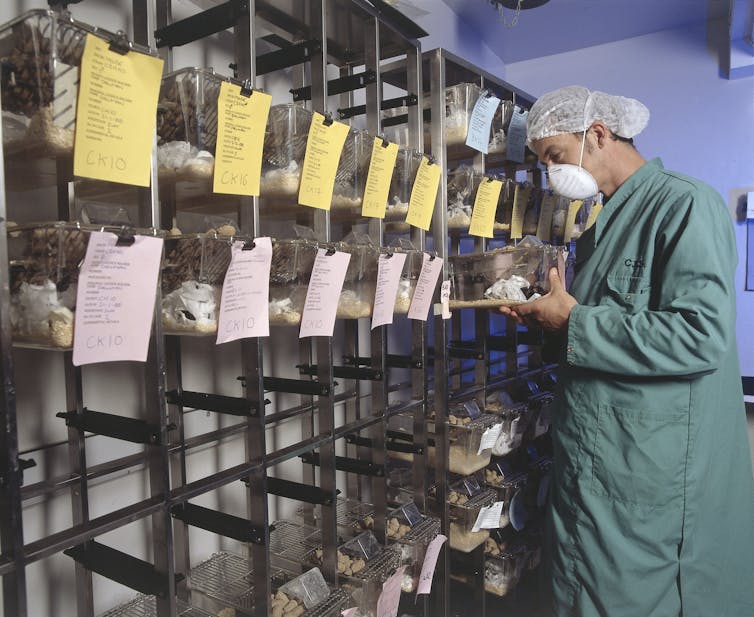Vague U.S. assurances spark concern about lost military equipment in Ukraine, a longtime hub of arms trafficking
By John Hudson
Yesterday at 6:00 a.m. EDT
Ukrainian soldiers train with U.S.-supplied Javelin missiles. (AP)
President Biden is expected to sign in the coming days a $40 billion security-assistance package that will supercharge the flow of missiles, rockets, artillery and drones to a war-torn Ukraine.
But what remains unclear is Washington’s ability to keep track of the powerful weapons as they enter one of the largest trafficking hubs in Europe.
President Biden is expected to sign in the coming days a $40 billion security-assistance package that will supercharge the flow of missiles, rockets, artillery and drones to a war-torn Ukraine.
But what remains unclear is Washington’s ability to keep track of the powerful weapons as they enter one of the largest trafficking hubs in Europe.
Ukraine’s illicit arms market has ballooned since Russia’s initial invasion in 2014, buttressed by a surplus of loose weapons and limited controls on their use.
This uncomfortable reality for the United States and its allies comes amid urgent pleas from President Volodymyr Zelensky to provide artillery needed to counter Russian forces in the country’s east and south. The Ukrainian leader’s appeals are credited with uniting House lawmakers behind the latest funding request in a bipartisan 368-to-57 vote on Tuesday. But the unprecedented influx of arms has prompted fears that some equipment could fall into the hands of Western adversaries or reemerge in faraway conflicts — for decades to come.
“It’s just impossible to keep track of not only where they’re all going and who is using them, but how they are being used,” said Rachel Stohl, an arms-control expert and vice president at the Stimson Center.
A State Department spokesman said the United States has conducted thorough vetting of the Ukrainian units it supplies while forcing Kyiv to sign agreements that “do not allow the retransfer of equipment to third parties without prior U.S. government authorization.”
But the means of enforcing such contracts are relatively weak — and made even weaker by Washington’s own mixed history of compliance, as recently as last month.
On the battlefield with Russia, Afghanistan’s loss is Ukraine’s gain
In mid-April, the United States boosted its involvement in the Ukraine conflict by announcing that it would transfer a fleet of Mi-17 helicopters to Ukraine that it originally purchased from Russia about a decade ago. The initial sale of the aircraft required the United States to sign a contract promising not to transfer the helicopters to any third country “without the approval of the Russian Federation,” according to a copy of the certificate posted on the website of Russia’s Federal Service on Military-Technical Cooperation.
Russia has denounced the transfer, saying it “grossly violates the foundations of international law.”
Arms experts say Russia’s brutal aggression in Ukraine more than justifies U.S. support, but the violation of weapons contracts chips away at the foundations of counter-proliferation efforts.
“Breaking of those end-use agreements is a serious threat to the underlying, but weak, capacity for countries to control how weapons are used,” said Jeff Abramson, an expert on conventional arms transfers at the Arms Control Association.
A Pentagon spokesman dismissed the criticisms, calling Russian charges a distraction and the transfer “permissible under U.S. law and consistent with our national security priorities.”
“Russia’s claims are a disingenuous attempt to distract attention from Russia’s unprovoked invasion and its history of aggressive actions against Ukraine since 2014,” said Marine Corps Lt. Colonel Anton T. Semelroth.
.jpg)
An Mi-17 helicopter over Afghanistan in 2010. (Petty Officer 2nd Class Vladimir Potapenko/U.S. Air Force)
The job of ensuring U.S. weapons are used for their intended purpose — a joint responsibility of the departments of State and Defense — is made all the more difficult by the sheer volume of arms making their way to Ukraine.
The emergency spending bill awaiting approval in the Senate will cement Ukraine’s status as the world’s single largest recipient of U.S. security assistance, receiving more in 2022 than the United States ever provided to Afghanistan, Iraq or Israel in a single year.
Pentagon will buy Ukraine laser-guided rockets, surveillance drones
It will add to the stocks of weapons the U.S. already committed to Ukraine, including 1,400 Stinger antiaircraft systems, 5,500 antitank missiles, 700 Switchblade drones, 90 long-range Howitzers artillery systems, 7,000 small arms, 50,000,000 rounds of ammunition, and numerous other mines, explosives and laser-guided rocket systems.
Shoulder-fired Stinger missiles, capable of downing commercial airliners, are just one of the weapon systems experts worry could slip into the possession of terrorist groups seeking to carry out mass-casualty events.
U.S. Marines in Twentynine Palms, Calif., test Stinger missiles during a training exercise. (Lance Cpl. Rachel Young/Marine Corps Air Ground Combat C)
The Biden administration’s funding request includes $8.7 billion to replenish U.S. stores of weapons shipped to Ukraine, $6 billion to train and equip Ukrainian forces and $3.9 billion for U.S. forces deployed throughout Europe in response to the security crisis that’s been set off by the war.
Other NATO countries have transferred billions of dollars in arms and military equipment since the start of hostilities.
“The assistance exceeds the peak year of U.S. military assistance to Afghan security forces during that 20-year war,” said William Hartung, an arms control expert at the Quincy Institute think tank. “In that case the U.S. had a major presence in-country that created at least the possibility of tracking where weapons were ending up. By comparison, the U.S. government is flying blind in terms of monitoring weapons supplied to civilian militias and the military in Ukraine.”
Ukraine’s history as a hub for arms trafficking dates to the fall of the Soviet Union, when the Soviet military left behind large amounts of small arms and light weapons in Ukraine without adequate record-keeping and inventory control. According to the Small Arms Survey, a Geneva-based research organization, a portion of the Ukrainian military’s 7.1 million small arms in stock in 1992 “were diverted to conflict areas” underscoring “the risk of leakage to the local black market.”
The Biden administration’s funding request includes $8.7 billion to replenish U.S. stores of weapons shipped to Ukraine, $6 billion to train and equip Ukrainian forces and $3.9 billion for U.S. forces deployed throughout Europe in response to the security crisis that’s been set off by the war.
Other NATO countries have transferred billions of dollars in arms and military equipment since the start of hostilities.
“The assistance exceeds the peak year of U.S. military assistance to Afghan security forces during that 20-year war,” said William Hartung, an arms control expert at the Quincy Institute think tank. “In that case the U.S. had a major presence in-country that created at least the possibility of tracking where weapons were ending up. By comparison, the U.S. government is flying blind in terms of monitoring weapons supplied to civilian militias and the military in Ukraine.”
Ukraine’s history as a hub for arms trafficking dates to the fall of the Soviet Union, when the Soviet military left behind large amounts of small arms and light weapons in Ukraine without adequate record-keeping and inventory control. According to the Small Arms Survey, a Geneva-based research organization, a portion of the Ukrainian military’s 7.1 million small arms in stock in 1992 “were diverted to conflict areas” underscoring “the risk of leakage to the local black market.”
The problem grew more acute after Russia’s invasion in 2014, which saw combatants looting arms and munition-storage facilities of Ukraine’s Security Service, Interior and Defense ministries. “Irregular fighters on both sides progressively gained access to a wide range of military-grade equipment, including the full spectrum of small arms and light weapons,” according to a report by the Small Arms Survey in 2017. “Officials estimated that at least 300,000 small arms and light weapons were looted or lost between 2013 and 2015,” providing a boon the country’s black market run by Mafia-style groups in Donbas region and other criminal networks.
The U.S. government is well aware of the country’s challenges with weapons proliferation, though it has been vague in describing the precautions it’s taking.
Weeks after Russia’s latest invasion of Ukraine on Feb. 24, a group of interagency officials in the Biden administration met with outside arms-control experts to discuss the risk of small-arms proliferation in the conflict. According to Stohl, who attended one of the meetings, U.S. officials offered assurances about vetting Ukrainian security forces and addressing reports of unauthorized transfer — but scant details on how the vetting or monitoring happens.
“It does not inspire much confidence,” said Stohl.
.jpg)
U.S. Marine Corps M777 towed 155 mm howitzers are staged on a flight line in California before being loaded onto aircraft bound for Europe and transfer to Ukrainian forces (U.S. Marines/Via Reuters)
Other arms experts feel similarly in the dark.
“It is unclear what risk mitigation or monitoring steps the U.S. and other countries have taken, or what guarantees they have obtained, to ensure the protection of civilians through these very large transfers,” said Annie Shiel, a senior adviser at the Center for Civilians in Conflict.
Some of the recommended steps include establishing a special investigator as the U.S. government did in Afghanistan, ensuring any weapons transfers contain strong tracking procedures, adding human rights obligations in the terms of sale and including specifics about what units can be authorized to receive such transfers. (In 2018, Congress banned Ukraine’s Azov battalion, a far-right nationalist group associated with neo-Nazism, from receiving U.S. weapons.)
There are additional concerns among watchdog groups about arms proliferation stemming from Moscow amid reports it has enlisted mercenaries from Libya, Syria and Chechnya, as well as the Wagner Group, a Russian contractor.
During a televised meeting of Russia’s Security Council in March, Defense Minister Sergei Shoigu said 16,000 volunteers in the Middle East stood ready to fight alongside Russian-backed forces in Eastern Ukraine.
In response, Russian President Vladimir Putin offered his approval, saying, “We need to give them what they want and help them get to the conflict zone.”
At the same meeting, Shoigu proposed handing over captured U.S. Javelin and Stinger missiles to pro-Russian separatists in Donbas region. “Please do this,” Putin told Shoigu.
The introduction of foreign fighters to a conflict runs the risks of weapons returning to those individuals’ countries of origin when the fighting in Ukraine ends. There are conflicting reports about the presence of foreign fighters there, however, and it’s unclear precisely how many have in fact traveled to Ukraine.
The lack of information has spurred calls for answers from the administration and attention from Congress.
“Some of the weapons being provided in the conflict in Ukraine are likely to be found years, and possibly decades later,” said Abramson. “Congressional leaders should be asking these questions, in classified briefings if needed, and the public should be better informed.”
Other arms experts feel similarly in the dark.
“It is unclear what risk mitigation or monitoring steps the U.S. and other countries have taken, or what guarantees they have obtained, to ensure the protection of civilians through these very large transfers,” said Annie Shiel, a senior adviser at the Center for Civilians in Conflict.
Some of the recommended steps include establishing a special investigator as the U.S. government did in Afghanistan, ensuring any weapons transfers contain strong tracking procedures, adding human rights obligations in the terms of sale and including specifics about what units can be authorized to receive such transfers. (In 2018, Congress banned Ukraine’s Azov battalion, a far-right nationalist group associated with neo-Nazism, from receiving U.S. weapons.)
There are additional concerns among watchdog groups about arms proliferation stemming from Moscow amid reports it has enlisted mercenaries from Libya, Syria and Chechnya, as well as the Wagner Group, a Russian contractor.
During a televised meeting of Russia’s Security Council in March, Defense Minister Sergei Shoigu said 16,000 volunteers in the Middle East stood ready to fight alongside Russian-backed forces in Eastern Ukraine.
In response, Russian President Vladimir Putin offered his approval, saying, “We need to give them what they want and help them get to the conflict zone.”
At the same meeting, Shoigu proposed handing over captured U.S. Javelin and Stinger missiles to pro-Russian separatists in Donbas region. “Please do this,” Putin told Shoigu.
The introduction of foreign fighters to a conflict runs the risks of weapons returning to those individuals’ countries of origin when the fighting in Ukraine ends. There are conflicting reports about the presence of foreign fighters there, however, and it’s unclear precisely how many have in fact traveled to Ukraine.
The lack of information has spurred calls for answers from the administration and attention from Congress.
“Some of the weapons being provided in the conflict in Ukraine are likely to be found years, and possibly decades later,” said Abramson. “Congressional leaders should be asking these questions, in classified briefings if needed, and the public should be better informed.”
.jpg)
.jpg)















